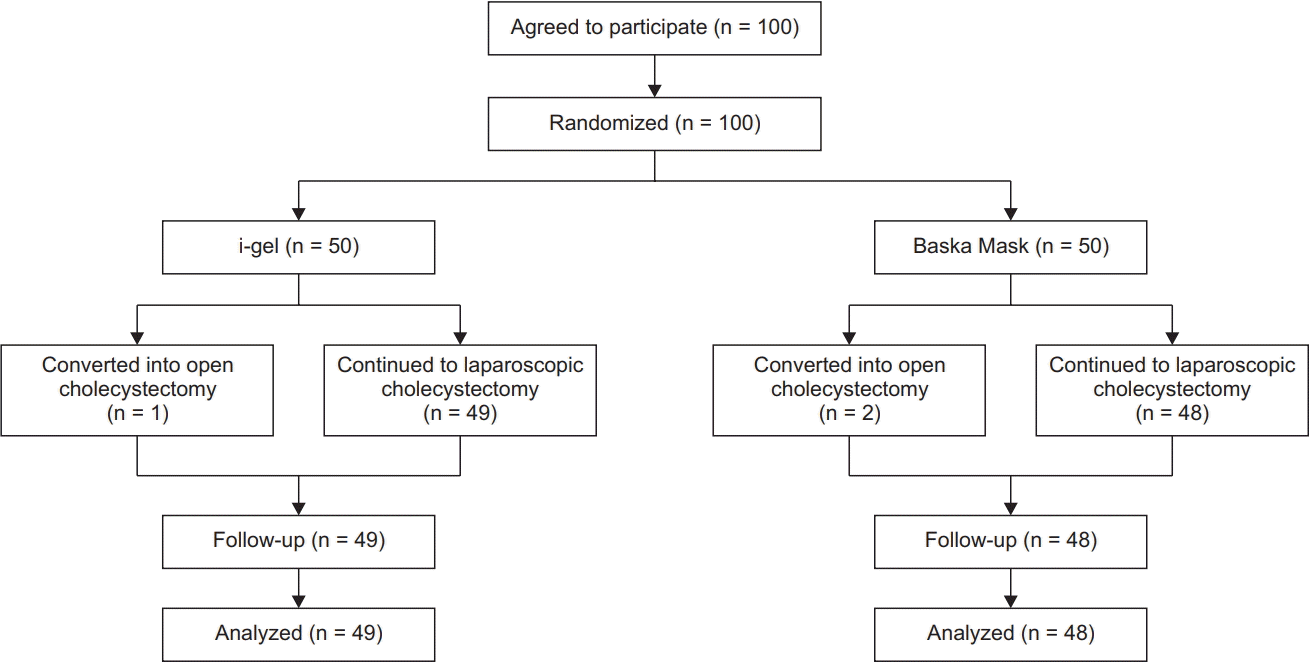1. Park SK, Ko G, Choi GJ, Ahn EJ, Kang H. Comparison between supraglottic airway devices and endotracheal tubes in patients undergoing laparoscopic surgery: A systematic review and meta-analysis. Medicine (Baltimore). 2016; 95:e4598.
2. Dhanda A, Singh S, Bhalotra AR, Chavali S. Clinical comparison of i-gel supraglottic airway device and cuffed endotracheal tube for pressure-controlled ventilation during routine surgical procedures. Turk J Anaesthesiol Reanim. 2017; 45:270–6.

3. Park SY, Rim JC, Kim H, Lee JH, Chung CJ. Comparison of i-gelⓇ and LMA SupremeⓇ during laparoscopic cholecystectomy. Korean J Anesthesiol. 2015; 68:455–61.

4. Lai CJ, Liu CM, Wu CY, Tsai FF, Tseng PH, Fan SZ. I-Gel is a suitable alternative to endotracheal tubes in the laparoscopic pneumoperitoneum and trendelenburg position. BMC Anesthesiol. 2017; 17:3.

5. Sharma B, Sehgal R, Sahai C, Sood J. PLMA vs. I-gel: a comparative evaluation of respiratory mechanics in laparoscopic cholecystectomy. J Anaesthesiol Clin Pharmacol. 2010; 26:451–7.
6. Alexiev V, Salim A, Kevin LG, Laffey JG. An observational study of the BaskaⓇ mask: a novel supraglottic airway. Anaesthesia. 2012; 67:640–5.
7. Alexiev V, Ochana A, Abdelrahman D, Coyne J, McDonnell JG, O'Toole DP, et al. Comparison of the Baska(Ⓡ) mask with the single-use laryngeal mask airway in low-risk female patients undergoing ambulatory surgery. Anaesthesia. 2013; 68:1026–32.
8. Foo LL, Shariffuddin II, Chaw SH, Lee PK, Lee CE, Chen YS, et al. Randomized comparison of the Baska FESS mask and the LMA Supreme in different head and neck positions. Expert Rev Med Devices. 2018; 15:597–603.

9. Høymork SC, Raeder J, Grimsmo B, Steen PA. Bispectral index, predicted and measured drug levels of target-controlled infusions of remifentanil and propofol during laparoscopic cholecystectomy and emergence. Acta Anaesthesiol Scand. 2000; 44:1138–44.

10. Liu SY, Leighton T, Davis I, Klein S, Lippmann M, Bongard F. Prospective analysis of cardiopulmonary responses to laparoscopic cholecystectomy. J Laparoendosc Surg. 1991; 1:241–6.

12. Keller C, Brimacombe JR, Keller K, Morris R. Comparison of four methods for assessing airway sealing pressure with the laryngeal mask airway in adult patients. Br J Anaesth. 1999; 82:286–7.
13. Keller C, Brimacombe J, Pühringer F. A fibreoptic scoring system to assess the position of laryngeal mask airway devices. Interobserver variability and a comparison between the standard, flexible and intubating laryngeal mask airways. Anasthesiol Intensivmed Notfallmed Schmerzther. 2000; 35:692–4.

14. Lee YC, Yoon KS, Park SY, Choi SR, Chung CJ. A comparison of i-gelTM and Laryngeal Mask Airway SupremeTM during general anesthesia in infants. Korean J Anesthesiol. 2018; 71:37–42.
15. Maltby JR, Beriault MT, Watson NC, Fick GH. Gastric distension and ventilation during laparoscopic cholecystectomy: LMA-Classic vs. tracheal intubation. Can J Anaesth. 2000; 47:622–6.

16. Raghavendran K, Nemzek J, Napolitano LM, Knight PR. Aspiration-induced lung injury. Crit Care Med. 2011; 39:818–26.

17. Tung A, Fergusson NA, Ng N, Hu V, Dormuth C, Griesdale DG. Pharmacological methods for reducing coughing on emergence from elective surgery after general anesthesia with endotracheal intubation: protocol for a systematic review of common medications and network meta-analysis. Syst Rev. 2019; 8:32.

18. Jouan ZT, Jawan B, Lee JH. Pulmonary edema complicated by post-extubation laryngospasm: a case report. Changgeng Yi Xue Za Zhi. 1997; 20:309–12.
19. Budania LS, Chamala V, Rao M, Virmani S, Goyal KA, Nanda K. Effect of air, anesthetic gas mixture, saline, or 2% lignocaine used for tracheal tube cuff inflation on coughing and laryngotracheal morbidity after tracheal extubation. J Anaesthesiol Clin Pharmacol. 2018; 34:386–91.
20. Versichelen L, Serreyn R, Rolly G, Vanderkerckhove D. Physiopathologic changes during anesthesia administration for gynecologic laparoscopy. J Reprod Med. 1984; 29:697–700.
21. Pelosi P, Foti G, Cereda M, Vicardi P, Gattinoni L. Effects of carbon dioxide insufflation for laparoscopic cholecystectomy on the respiratory system. Anaesthesia. 1996; 51:744–9.

22. O'Malley C, Cunningham AJ. Physiologic changes during laparoscopy. Anesthesiol Clin North Am. 2001; 19:1–19.
23. Cunningham AJ, Brull SJ. Laparoscopic cholecystectomy: anesthetic implications. Anesth Analg. 1993; 76:1120–33.
24. Mukadder S, Zekine B, Erdogan KG, Ulku O, Muharrem U, Saim Y, et al. Comparison of the proseal, supreme, and i-gel SAD in gynecological laparoscopic surgeries. ScientificWorldJournal. 2015; 2015:634320.

25. Ismail SA, Bisher NA, Kandil HW, Mowafi HA, Atawia HA. Intraocular pressure and haemodynamic responses to insertion of the i-gel, laryngeal mask airway or endotracheal tube. Eur J Anaesthesiol. 2011; 28:443–8.

26. Aydogmus MT, Turk HS, Oba S, Unsal O, Sinikoglu SN. Can SupremeTM laryngeal mask airway be an alternative to endotracheal intubation in laparoscopic surgery? Braz J Anesthesiol. 2014; 64:66–70.
27. Brimacombe J, Holyoake L, Keller C, Brimacombe N, Scully M, Barry J, et al. Pharyngolaryngeal, neck, and jaw discomfort after anesthesia with the face mask and laryngeal mask airway at high and low cuff volumes in males and females. Anesthesiology. 2000; 93:26–31.






 Citation
Citation Print
Print





 XML Download
XML Download